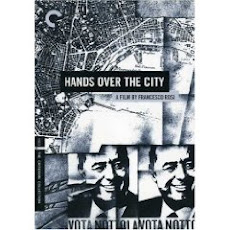
One of the things that struck me about Hands Over the City was the number of representations of the city that appear. So much of the film is structured around ways of describing the city. We see Nottola's model (above) - we see several maps - we see his office, with a map painting on one wall, huge photos of the city on other walls, as well as windows looking at the city, and the model itself. But the city is represented by more than just images - there are words and numbers about the city, reports, statistics. The archive room is as much a representation of the city as the maps are.

But none of these representations are adequate - they are often quite flawed. The episode discussing the common wall of the house that collapsed is a case in point: the officials explain that they had no way of knowing - the scale of the map would make a meter thick wall 1/2mm wide line - their pens have 1 mm nibs - they can't represent the real width with their tools. It's a common theme - the reports are all accurate, in their way - but all miss things. You see the various officials making excuses and avoiding responsibilities - but their information, their maps, records, etc., are all equally ambiguous. The representations of the city tend to hide it as much as reveal it. Da Vita gets at this, with his all too apt metaphor - everything was by the book, but the book needs to be rewritten...

While most of this misreading and ambiguity is unintentional, Nottola emerges as a character who can exert willing control over things. He is determined and focused, he knows what he wants. And he sees - and he promises a view of the bay to everyone.. He can imagine it, and represent it - hreates the big model - his office is lined with maps and pictures. He is a visionary - he imagines the city as it will become, he sees it when it is not there. He will build it - but before he builds it, he imagines it, he is, rather literally, a writer of the city:

Now it is true, he is as apt to see the profits he can get as the biuldings he can build - he still falls into that class of ambiguous villains, the 20th century developer. There was a nice piece in the New York Times about a new book about Jane Jacobs and Robert Moses, her campaign to stop him from bulldozing Greenwich Village for a superhighway, or driving an interstate through Washington Square Park. Nottola is in the same vein as Moses - more of a crook, maybe, but still, someone trying to realize a vision of a city - though a vision that usually forgets about the people living there. Or reduce them to lists of names...

Anyway - it's a good film about a pretty substantial part of 20th century social history - the reinvention of cities. A process still going on - there are echoes of this film in recent films about urban renewal - Pedro Costa's In Vanda's Room and Colossal Youth, or Jose Luis Guerin's Under Construction - complete with the tour of the new buildings - handsome, safe, boring, and priced out of reach of the people who are being displaced...




